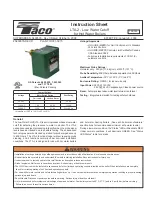
IBC Technologies Inc.
42
VFC 15-150 and VFC 45-225
4.3 TROUBLESHOOTING
GUIDE
The troubleshooting section is divided into
2 sections:
•
Preliminary checks
•
Detailed systems review
Often, a problem can be identified and
solved through simple checks of the
basics: confirming the electrical power
supply, gas flow and resetting the
thermostat control. To extend the cover of
such preliminary checks, the boiler’s
control module offers a clear visual display
of the status of the various control circuit
components.
Should a problem remain unsolved after
applying the preliminary checks, proceed
to the detailed system review, using the
Troubleshooting Guide. The Guide covers
potential error conditions as grouped into
the following categories:
•
Ignition
•
Cycling
•
Temperature
Below each section is a list of Symptoms,
Diagnoses, and Remedies.
Also provided with this manual are 4
diagrams for use with troubleshooting
including
•
electrical wiring diagram
•
sequence of operations flowchart
•
boiler component layout diagram
•
troubleshooting flowchart
4.3.1 Preliminary Checks
The first step in troubleshooting this system should be a review of the Controller’s LCD
screen. There are a number of diagnostic features incorporated in the software that evaluate
system integrity, display error conditions and provide initial suggested remedial actions
Section 2.6.6 - Error Mode
.
In addition to checking the display, the following list is a guideline for troubleshooting:
1.
Confirm power to the boiler: check that control module display is on (e.g. display is lit).
2.
Check that boiler is not in a safety lockout.
3.
Ensure wiring is clean and secure.
4.
Check that gas is reaching the unit.
5.
Confirm water system is properly charged to 12 psig and pump is serviceable.
4.3.2 Troubleshooting Electronic Components
This section details the method for troubleshooting the non-standard electronic components
on the boiler including the electronic differential air pressure sensor and the temperature
sensors.
4.3.2.1
Temperature Sensors
The resistance of the temperature sensors varies inversely with temperature. To test, measure
the temperature of the sensed environment and compare with the value derived from the
measurement of the resistance (obtained by connecting a good quality test meter capable of
measuring up to 5,000 k
Ω
(5,000,000
Ω
) at the controller end of the sensor lead).
To obtain a resistance reading, remove power to the boiler. Locate the blue 2-wire leads
coming from the tekmar 071 sensors, which are affixed to the boiler supply and return piping
















































